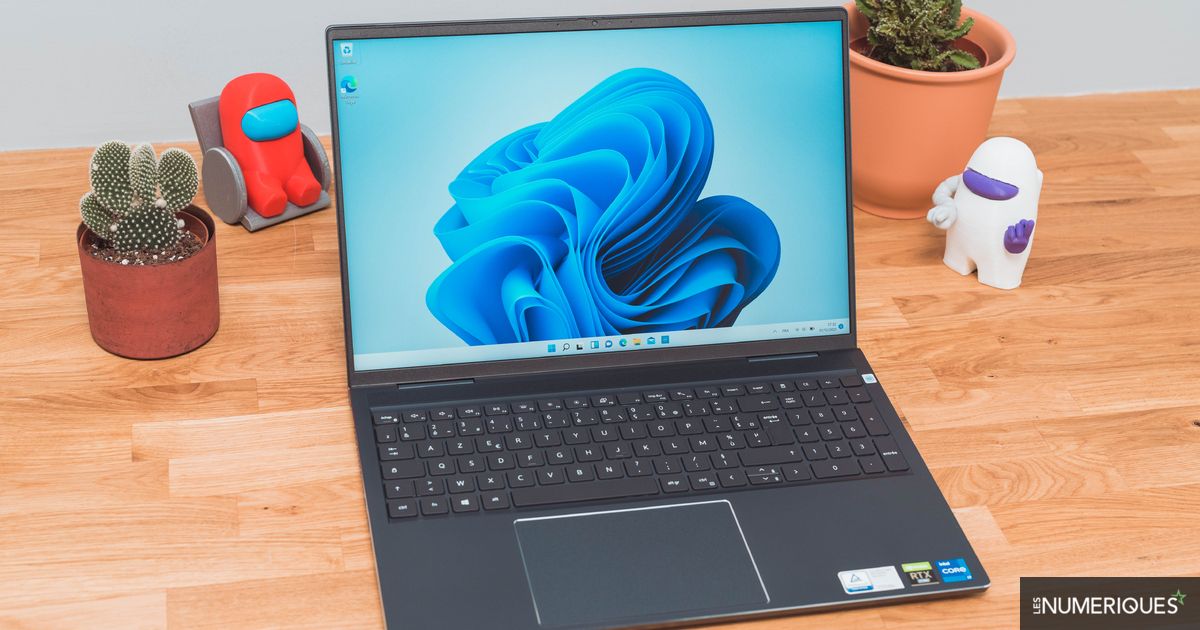Dell is accustomed to excellent build quality with the XPS series, and this Inspiron 16 Plus doesn’t budge. Its bluish-aluminum frame is very solid and the finish is impeccable with chrome borders adorning the perimeter of the bezel and touchpad. The 16:10 screen’s thin bezels also enhance the PC’s premium look, without being on the level with its XPS cousin.
Nothing to report on the keyboard side as typing remains fun. The numeric keypad on the right is included, as well as a fingerprint reader for quick unlocking of the computer. The backlight is only adjustable in three levels, and it is a little light. The touchpad is quite large and smooth to use; However, we regret that it sinks a lot under pressure, especially on the bottom edge.
The keyboard has a numeric keypad and a fingerprint reader.
The 720p webcam is not compatible with Windows Hello and therefore does not provide facial recognition. On the other hand, it has a manual cache that you just need to swipe to deactivate. A security feature we see appearing more and more on the latest computers, useful for cutting video in meetings for example. Unfortunately, the view of the webcam is not very good, and as soon as the brightness drops a little, the image quickly becomes pixelated.
The webcam has a manual cover.
Full contact on the edges. There are two USB-A 3.2 ports, a DisplayPort-compatible Thunderbolt 4 port (allows PC charging), an HDMI 2.0 port, an SD card reader and a mini-jack. Something that satisfies almost all uses.
Contact is provided.
Dell chose Phillips screws on the exterior and interior of the PC, which is a good idea that allows most people to access components without specific tools. Inside, under the metal and plastic covers we find a removable M2 SSD, two modules of RAM (which can also be removed) and a free slot for the small M2 2230 SSD. This complete scalability is a good surprise, plus the battery can be changed without much fiddling.
Free slot for M2 SSD plus removable SSD and RAM modules.
The cooling system works well as temperatures remain contained despite the heat generated by the graphics card. There’s a hot spot of around 46°C at the top of the keyboard, and just over 47°C at the air outlets during full gameplay, which stays pretty cool. The Inspiron 16 Plus, on the other hand, is noisy when the ventilation is running at full speed. So we observed a peak at 41.2 dB: lower than large PCs the games, but clearly audible.
The computer gets a little hot at the top of the keyboard.
The Dell Inspiron 16 Plus we’re testing here is equipped with a high-end Intel Core i7-11800H processor, GeForce RTX 3050 graphics, 16GB of RAM and 1TB of SSD. 2.3GHz with 4.6GHz turbo. It benefits from a high heat 45W casing. It was therefore able to hit an average of 2.9GHz on HandBrake, a good performance that explains the high CPU benchmark that puts it slightly ahead of the Ryzen 7 5800H.
A dedicated PC graphics card allows hardware acceleration to be activated in certain programs such as Photoshop or Adobe Premiere, which makes it particularly interesting for professionals and creators. Thus, processing times are much faster than using a single processor, even if the computer is clearly not as efficient as the RTX 3060, 3070, or 3080-equipped models. In Blender, for example, the project’s 3D rendering time is halved than By enabling GPU acceleration, the RTX 3050 is still twice as slow as the RTX 3060.
GPU acceleration provides significant time savings in some programs.
If this PC is intended for this type of task as it has proven to be effective, then of course it can be used for gaming and the RTX 3050 takes advantage of DLSS and raytracing technologies. permissive games like Diablo III (high graphics) and Note and watch (Poor graphics) I managed to far exceed 60fps a 60Hz PC monitor can display by setting the resolution to 1920×1200 pixels (153fps and 162fps respectively). employment Assassin’s Creed ValhallaHowever, the graphics settings set to Ultra are a bit demanding for PCs that only hit 40 fps on average. So it will be necessary to lower the graphics for more fluidity and get closer to 60 frames per second.

“Certified gamer. Problem solver. Internet enthusiast. Twitter scholar. Infuriatingly humble alcohol geek. Tv guru.”





